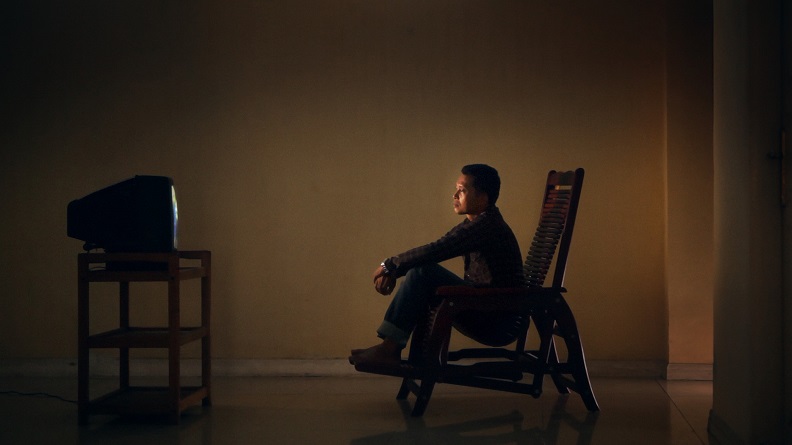The Look of Silence
Director: Joshua Oppenheimer
5:30 & 8 p.m. Friday, 5:30 p.m. Saturday, 5:30 p.m. Sunday, 5:30 p.m. Thursday
Oklahoma City Museum of Art
A
In 2012, Joshua Oppenheimer’s The Act of Killing threaded an illustrious strain through life after the communist genocide in Indonesia. Anwar, killer of a thousand people and former leader of ’60s death squads, stumbled upon an untapped geyser of regret after loosely reenacting many of his countless atrocities. Fortunately for Anwar, he never had to confront his victims’ next of kin. With The Look of Silence, Oppenheimer takes his piercing examination into the depths of the human condition one step further, sparing the theatrics for a series of conversations tackling a difficult subject.
Adi, an optician living near Aceh, Indonesia, struggles to take care of his parents. Plagued by the violent death of their other son Ramli in 1965, the duo — both of whom exceed nearly a century in age — find hope in the progressive-minded Adi. Oppenheimer presents the surviving sibling with a video he recorded in 2003, which documents Ramli’s killer reflecting over his violent actions with a pleasant nostalgia. Desperate to dive deeper into the event that has retconned a history not far removed, Adi confronts those responsible for this crescendo of human depravity.
Thematically, The Look of Silence conjures notions of a faint yet steadily germinating optimism. Initially reluctant to forgive the seemingly oblivious war criminals, Adi begins to foster a speck of exoneration. For example, despite the tireless and contextually skewed lectures of the Indonesian school teachers, Adi’s daughter retains a sense of humor with everything, playfully mocking her father’s occupation and later singing about her flatulence. Similarly, his blind and dementia-ridden father continually insists on his meager of 16, despite his 1904 birthdate. The fading elder strives to retain some semblance of youthful energy, ironically singing to his wife, “you’re so sexy I can’t stand it.”
Oppenheimer’s imagery reflects a similar quality. Periodic shots of a few stirring jumping beans create a relevant allegory. Although their ugly, unassuming appearance reflects something pathetic, Adi’s daughter insists that there’s “a butterfly inside.” One particularly stunning scene finds Adi’s mother tending her garden as the sun shines through the thin trunks of a tree cluster. A beam illuminates the old woman, emphasizing the nook of fresh vegetables nestled between her dirt-covered feet. Feeling futile as her husband hardly has the strength to eat, Adi’s mother continues to cultivate a life’s work that has long begotten her darkest tragedy: the death of Ramli. After all, if she were to halt, what’s to stop the plants from falling into unmanageable chaos?
The Look of Silence’s strongest suit, of course, comes in the form of Adi’s conversations. In one scene, Adi visits a former death squad captain to fit him for new frames and press him on his murderous actions. Matter-of-factly at first, the war criminal insists that what kept him from going insane was his persistence to drink the blood of the communists — described as both “salty and sweet.” Adi remains dauntless, contending that the Western propaganda that whipped many of the Islamists into a violent cyclone was just that: utter fabrication. The old man stares angrily at Adi, his lips quivering and his right eye trembling with lethal folly. Unfortunately, a favorable social position has given the man little atonement.
While still wielding his signature gaze that seems to have granted the film its namesake, Adi shifts his focus to his own generation and younger in the piece’s final act. One conversation with a senile general and his daughter leads to a particularly difficult interaction when the daughter realizes that her father — whom she has forfeited her life to take care of — violently hacked people in two, draining their innards. The woman quickly begs Adi to forgive her father sitting right beside her.
During this moment, Adi approaches an unsettling truth: Much to his dismay, the generation of his parents (themselves included) is too far removed from anything less than the most vindictive form of reconciliation. The seniors would rather lose their minds before forfeiting their longstanding convictions.
With this, Oppenheimer weaves the final inch of the tapestry he’s spun for the past 12 years. Though Anwar, of The Act of Killing, may feel intense guilt, the recognition of such is not at all worth the loss of comfort. Age, it seems, solidifies all stigmas.
Though The Act of Killing was undoubtedly important, Oppenheimer’s follow-up — a critique of xenophobia, demonization, and ultimately senseless violence — is even more so. Like its companion, The Look of Silence may have an uneventful awards campaign. But it has something very few documentaries (let alone movies) obtain: timelessness.





